|
|
|
Sort Order |
|
|
|
Items / Page
|
|
|
|
|
|
|
| Srl | Item |
| 1 |
ID:
186131
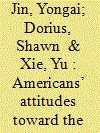

|
|
|
|
|
| Summary/Abstract |
The US public holds more nuanced views about China than are typically captured in public opinion surveys. Empirical investigation of a nationwide online survey of US adults shows that the American public is sharply divided over the US–China trade war, despite reporting high support for international trade with China (76%). Using survey questions on US–China trade and the trade war, a typology was developed that indicates more than 40% of US adults support trade with China but oppose the trade war. A slightly smaller share has a more economically militant view of trade with China, supporting trade and the trade war. Political identity is strongly associated with attitudes toward the trade war, but only weakly associated with attitudes toward trade with China. Perceptions about China and its government, people, and culture are highly correlated with views on trade with China but are unrelated to views on the trade war.
|
|
|
|
|
|
|
|
|
|
|
|
|
|
|
|
| 2 |
ID:
164942
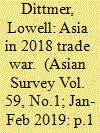

|
|
|
| 3 |
ID:
007267
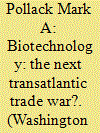

|
|
|
|
|
| Publication |
Autumn 2000.
|
| Description |
41-54
|
|
|
|
|
|
|
|
|
|
|
|
|
|
|
|
| 4 |
ID:
161579
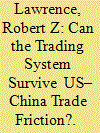

|
|
|
|
|
| Summary/Abstract |
Donald Trump has sought to change US trading relationships by raising protection at home and taxing the offshore activities of US companies abroad. These measures, which both use and violate trade rules, have provoked retaliation from other countries. Such friction has restricted and distorted trade and investment, undermined the rules‐based trading system and perhaps permanently damaged global value chains that depend on stable rules for market access. Trump has justified some of his measures as a response to China's alleged unfair practices and indeed, China has adopted industrial and technology policies that are formally neutral between domestic and foreign firms but in practice have led foreign firms to complain about discriminatory practices that favor Chinese firms. The US friction with China is unfortunate because instead of trying to bully China into submission in a tariff war, the US could have dealt with many of its concerns more effectively by cooperating with other countries and taking actions that are consistent with maintaining the rules‐based system. While the US has undermined its leadership role, the overall damage to the trading system could still be limited if other countries, especially China, take actions that sustain and strengthen it.
|
|
|
|
|
|
|
|
|
|
|
|
|
|
|
|
| 5 |
ID:
161577
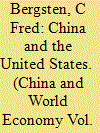

|
|
|
|
|
| Summary/Abstract |
This paper considers whether there is a “Thucydides trap” in the world economy, referring to the inherent conflict between incumbent and challenger. It assesses the impact of President Trump's alienation of traditional US allies, which threatens to splinter the “hegemonic coalition” and even push China and Europe together, and his convergence toward some Chinese norms on trade and even politics. It outlines three possible systemic scenarios: a “G0” in which the US is no longer willing to lead but China is not yet able or willing, and whether such a (likely) regime will be stable or unstable; a new “G1,” sooner or later, led by China; and a cooperative “G2” in which the US and China agree to share leadership. It traces the evolution of actual leadership initiatives of the two countries in recent years. It compares US and Chinese attitudes on key systemic issues and concludes with an appraisal of “an international economic order with Chinese characteristics,” a world in which the state plays a greater role relative to market economics, the rule of law defers increasingly to voluntary arrangements, and politics tilt toward central government control more than democracy.
|
|
|
|
|
|
|
|
|
|
|
|
|
|
|
|
| 6 |
ID:
164944
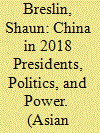

|
|
|
|
|
| Summary/Abstract |
President Xi Jinping dominated the Chinese stage during 2018, continuing to consolidate his power as the CCP sought to reassert its primacy. China flexed its muscles as a great power in a pitch for global leadership. Xi pushed constantly to portray China as the promoter of an open global economy, even as his own continued to slow incrementally amid the widening trade war with the US.
|
|
|
|
|
|
|
|
|
|
|
|
|
|
|
|
| 7 |
ID:
172457
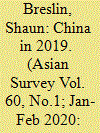

|
|
|
|
|
| Summary/Abstract |
In a year of considerable pomp and circumstance at home, China’s leaders continued to focus on how to deal with slowing economic growth, and the need for greater unity and support for the party (and Xi’s) priorities and goals. Despite efforts to persuade others of the global benefits of China’s rise, a number of key international actors seemed to increasingly think otherwise.
|
|
|
|
|
|
|
|
|
|
|
|
|
|
|
|
| 8 |
ID:
116496
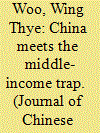

|
|
|
|
|
| Publication |
2012.
|
| Summary/Abstract |
We follow Woo (2011) in using the Catch-Up Index (CUI) to define the middle-income trap and identify the countries caught in it. The CUI shows that China became a middle-income country in 2007-2008. We see five major types of middle-income trap to which China is vulnerable: (a) fiscal stress from the nonperforming loans generated by the interaction between the lending practices of the state banks and the innate desire by state enterprise managers to over-invest and embezzle; (b) the frequent use of macro-stabilization tools that hurt long-term productivity growth; (c) flaws in socio-political governance that exacerbate social tensions; (d) ineffective management of environmental challenges that threaten sustainable development; and (e) inept handling of international economic tensions that could unleash trade conflict. We recommend new governance principles and management methods to prevent China from falling into these five types of middle-income trap.
|
|
|
|
|
|
|
|
|
|
|
|
|
|
|
|
| 9 |
ID:
173295
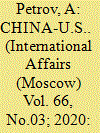

|
|
|
|
|
| Summary/Abstract |
THE U.S.-INITIATED disruption of the status quo in trade with China has laid the foundation for fundamental changes in relations between Washington and Beijing, and established a confrontational track for their development in the coming years and possibly even decades. A significant increase in trade barriers between the two largest economies in the world has left its mark on global trade and economic ties. At the height of the tariff war in late 2019, the U.S. levied duties on $375 billion worth of Chinese imports, and China imposed duties on $110 billion in supplies from the U.S. According to the IMF, this led to a 0.8% decline in global GDP by 2020.1 In January 2020, Beijing and Washington signed the "first phase" of a trade agreement that was supposed to iron out the disagreements between the countries. But the truce has so far raised more questions than answers.
|
|
|
|
|
|
|
|
|
|
|
|
|
|
|
|
| 10 |
ID:
105947


|
|
|
|
|
| Publication |
2011.
|
| Summary/Abstract |
The study of international rivalry is a thriving research program in international relations, but it focuses primarily on strategic rivalries and generally neglects both commercial rivalries and the impact of domestic politics. We examine commercial rivalry and the causal paths through which it can escalate to war. After identifying alternative theoretical explanations, we focus on the Anglo-Spanish rivalry of the 1730s and the processes through which it escalated to the War of Jenkins' Ear (1739-48). We examine both balance of power and dyadic trade rivalry explanations, and then give special attention to domestic politics in Britain. We argue that the commercial rivalry was a necessary but not sufficient condition for the war of 1739. The Walpole ministry was opposed to war, and the rivalry would not have escalated in the absence of domestic pressures from mercantile interests, a xenophobic public, a politically opportunistic parliamentary opposition, and a divided cabinet.
|
|
|
|
|
|
|
|
|
|
|
|
|
|
|
|
| 11 |
ID:
167738
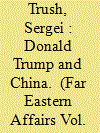

|
|
|
|
|
| Summary/Abstract |
China and questions about U.S.-PRC relations are now a topic that runs through the Trump administration, in terms of both domestic and foreign policies. In the 2017 U.S. National Security Strategy, Washington specified China as America's "main competitor" for the first time. In China's opinion, it has the right within the confines of a "trade war" to take such measures as protecting its domestic market and national economy, which do not contradict the norms of the World Trade Organization (WTO). China is still not ready to do what the United States did, i.e., capitalize its economic resources and structure, bring branches of the economy into the world division of labor, or create value chains while dominating them as widely and thoroughly as the Americans have. Elements of "trilateralism" are growing in relations between Russia, China, and the United States.
|
|
|
|
|
|
|
|
|
|
|
|
|
|
|
|
| 12 |
ID:
162647
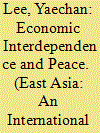

|
|
|
|
|
| Summary/Abstract |
Liberalists have argued that increased economic interdependence will deter the likelihood of war as opportunity costs of a military conflict will not be fashionable for either side. Realists such as Waltz contended that while interdependence promotes peace to a certain extent, it also multiplies the occasions for conflicts. Dale Copeland drew perspectives from both sides to argue that interdependence may lead to peace depending on the expectations of the future trade environment. Now, with the United States’ (US) ongoing trade war with China and its legacy of trade conflicts with Japan in the 1990s, the question of whether economic interdependence brings peace deserves to be revisited. This article, through making a comparison between the cases of bilateral trade conflicts between the US and China and the US and Japan, contends that increased bilateral economic interdependence also increased the frequency of conflicts in the two respective cases. Moreover, it further argues that such increase in frequency was due to the US’s negative expectations on the future trade environment.
|
|
|
|
|
|
|
|
|
|
|
|
|
|
|
|
| 13 |
ID:
177645
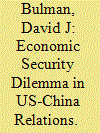

|
|
|
|
|
| Summary/Abstract |
China and the United States are caught in an economic security dilemma. In response to perceived economic aggression,
both countries now feel impelled to bolster domestic economic security through protectionist and retaliatory measures that the other side perceives as threatening. In game
theoretic terms, a mutually beneficial “Stag Hunt” coordination game devolved into an uncooperative “Prisoner’s Dilemma” after the global financial crisis. In the economic security dilemma that emerged under Trump and Xi, both sides
unsuccessfully attempted to coerce opponent behavior, further harming both economies. Using a game framework—as
opposed to a structural or leadership-based account—helps
demonstrate that China’s recent reform reversal and revisionist approaches to the international economic order were
not unavoidable parts of a long-term strategy, but rather developed partially as a response to perceived US aggressions.
|
|
|
|
|
|
|
|
|
|
|
|
|
|
|
|
| 14 |
ID:
099650
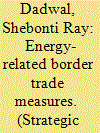

|
|
|
|
|
| Publication |
2010.
|
| Summary/Abstract |
Following the recent economic crisis, concerns over the revival of trade protectionism have surfaced, with some countries imposing or threatening to impose highly trade-distorting legislation to help their domestic industries compete in world markets, raising the spectre of a potential trade war. This paper looks at the attempts by some of the developed countries to introduce trade measures using the issue of climate change as a Trojan horse, to ensure that they do not lose out to the emerging economies. It also looks at the proposed legislations, and whether they are in conflict with international trade laws.
|
|
|
|
|
|
|
|
|
|
|
|
|
|
|
|
| 15 |
ID:
167324
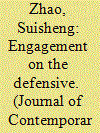

|
|
|
|
|
| Summary/Abstract |
Facing powerful challenges from both China and the US, the long-standing engagement policy is on the defensive. Focusing on advancing American economic and security interests rather than its ideals and prioritizing reciprocity above economic cooperation, the Trump administration has declared China a strategic competitor and escalated a trade war into a multi-front conflict. However, profound interdependence continues underpinning the bilateral relationship. Neither the US nor China can afford to disengage from the other. The two countries are not natural partners but not inevitable enemies either. Competition does not mean confrontation, much less war. Engagement remains the foundation for healthy competition.
|
|
|
|
|
|
|
|
|
|
|
|
|
|
|
|
| 16 |
ID:
187152
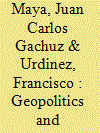

|
|
|
|
|
| Summary/Abstract |
The Bretton Woods institutions have failed to accommodate a rising China, and many authors describe this moment as a crisis of the liberal order, which China is intentionally contesting. The World Trade Organization was incapable of offering a solution to the trade war, and more recently, the World Health Organization was incapable of reducing – and rather partly contributed to – tensions between the US and China in the management of COVID-19 crisis. This Special Issue is made up of six manuscripts that address the most sensitive issues of the China–Latin American relationship amid the challenges of the growing dispute with the United States. The manuscripts assess the four main concerns that are shaping the agenda in China–Latin American relations in times of increasing geopolitical and geoeconomic competition between the United States and China: the Belt and Road Initiative, the One-China policy, the trade war, and the COVID-19 crisis.
|
|
|
|
|
|
|
|
|
|
|
|
|
|
|
|
| 17 |
ID:
173466
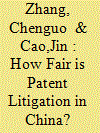

|
|
|
|
|
| Summary/Abstract |
By conducting field research and analysing judgments delivered in Beijing courts from 2004 to 2011, we find that the popular notion held by China's trade partners of the inadequacy of intellectual property protection is only partly supported by the empirical evidence. The likelihood of winning lawsuits is higher for foreign than domestic plaintiffs and the extremely low damages ruled by Chinese courts are due to particular causes. Courts lack consistent methods to calculate incurred losses in intellectual property right (IPR) infringements and consequently routinely apply the statutory damages whose upper limit is restricted by legislation. Efforts by Chinese legislators to enhance compensation by lifting the upper limit of awardable statutory damages in the Third Amendment of Chinese Patent Law (2008) did not seem to have an effect on our sample. Chinese policymakers should instead focus on the cause of the issue by providing more implementable guidelines for courts to calculate losses. Courts need to develop applicable conventions for calculating damages, based on objective criteria of how much compensation ought to be payable, which is also the basis of calculating reasonable statutory damages. Thus, the new provision of the “right of information” on pirated goods proposed by the ongoing Fourth Amendment provides a significant weapon to combat counterfeiting.
|
|
|
|
|
|
|
|
|
|
|
|
|
|
|
|
| 18 |
ID:
177623
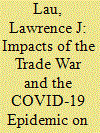

|
|
|
|
|
| Summary/Abstract |
The China-U.S. trade war reduced the Chinese growth rate from 6.9 percent in 2017 to 6.1 percent in 2019. The COVID-19 epidemic has lowered the rate further to 1.8 percent in the first half of 2020 and to a projected 3.4 percent for 2020 as a whole. The trade war caused only a very slight decline in the U.S. growth rate in 2019, but the COVID-19 epidemic has resulted in a projected contraction of 5.3 percent in 2020. Assuming that half of the Chinese exports to the United States were halted, it would imply a total loss of Chinese GDP of almost 1 percent, or approximately US$135 billion (in 2019 prices). Assuming that half of U.S. exports of goods to China were halted, it would imply a loss of U.S. GDP of 0.22 percent, or approximately US$47 billion. The costs of the trade war are higher for China than for the United States both absolutely and relatively. The loss of Chinese GDP due to COVID-19 in 2020 may be estimated as 3.5 percent of its 2019 value, or US$0.5 trillion. The corresponding loss of U.S. GDP may be estimated as 8.1 percent of its 2019 value, or US$1.73 trillion.
|
|
|
|
|
|
|
|
|
|
|
|
|
|
|
|
| 19 |
ID:
167997
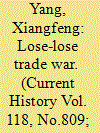

|
|
|
|
|
| Summary/Abstract |
“The feud not only has precipitated an economic decoupling of the United States and China, but also has pushed the overall bilateral relationship to its lowest point in half a century.”
|
|
|
|
|
|
|
|
|
|
|
|
|
|
|
|
| 20 |
ID:
187156
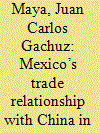

|
|
|
|
|
| Summary/Abstract |
The Mexico–China economic relationship is highly asymmetric, although the amount of total trade between the two countries has grown rapidly in the last ten years. Chinese exports to Mexico have grown exponentially and have diversified into different economic sectors. In contrast, Mexican exports to China have also grown but at a much slower pace and the pattern shows more concentration in fewer products. Paradoxically, in the context of the United States–China trade war, the Mexican economy has benefitted from the increase in tariffs that the United States has imposed on Chinese products. In 2019, for the first time, Mexico displaced China as a main trade partner of the United States. In this context, this article analyses the current economic relationship of Mexico with China and the United States in a triangular scheme, the impact of the United States–Mexico–Canada Agreement on the China–Mexico relationship, and Mexico's trade relationship with both economies in the context of the trade war.
|
|
|
|
|
|
|
|
|
|
|
|
|
|
|
|
|
|
|
|
|